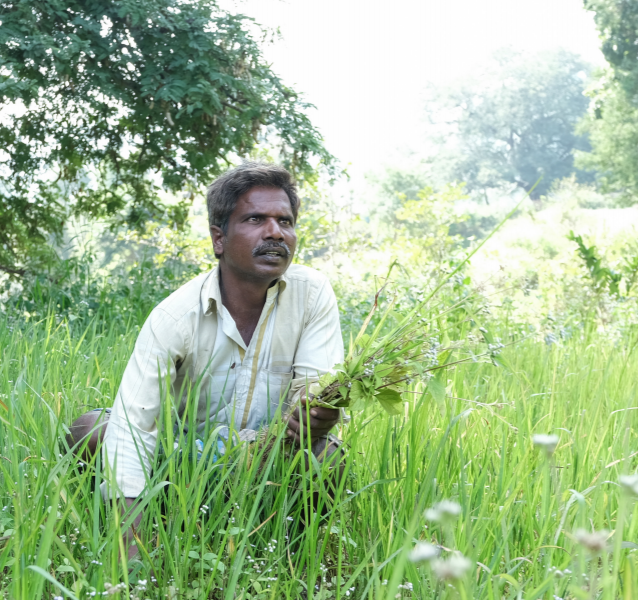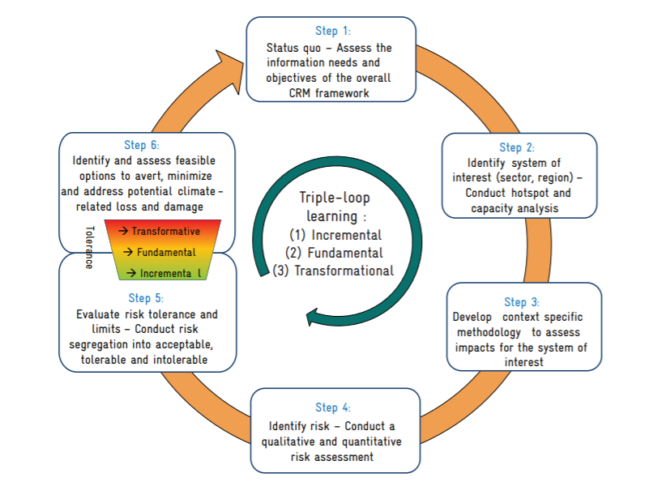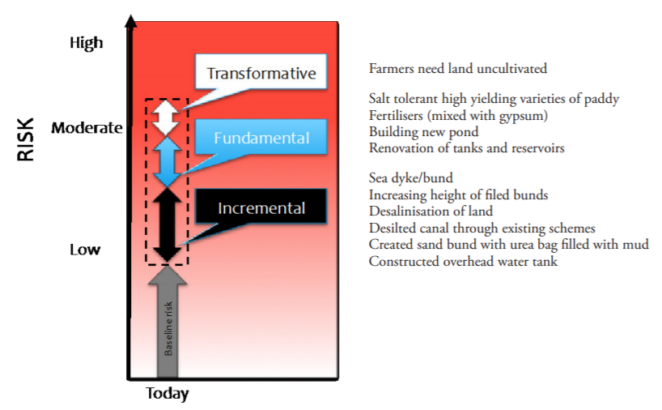Climate Risk Management Framework for India: Addressing Loss and Damage (L&D)

Introduction
Globally, weather and climate-related risks, which potentially cause loss and damage, have increased dramatically over the past few decades. Internationally there is an increasing recognition that adaptation and mitigation may not be enough to manage the impacts of climate change and both climate science and the international climate negotiations stress the urgent need to develop and implement effective climate risk assessment and management approaches in order to avert, minimize and address losses and damages.
While a number of approaches already exist in the field of short-term risk assessment and management, mainly in the field of extreme events, existing approaches do often not sufficiently address long-term, slow-onset changes due to climate change. Also, risk and vulnerability assessments often do not meet the information needs of policy-makers and local governments in order to manage the risks of climate change and associated losses and damages effectively.
Against this background, the German Federal Ministry for Economic Cooperation and Development (BMZ) commissioned GIZ with the implementation of the global programme on ‘Risk Assessment and Management for Adaptation to Climate Change’. The programme aims at generating practical guidelines and recommendations on climate risk assessment and effective climate risk management for the international partners of German Development Cooperation worldwide.
This project, cooperating with the BMZ financed project Climate Change Adaptation in Rural Areas of India (CCA RAI) and partnering with KPMG India and IIASA, develops a generic Climate Risk Management (CRM) framework (building on ongoing GIZ applications, such as in Tanzania) that can be utilized to assess and develop various measures at various levels when dealing with large scale climate vulnerabilities as well as residual risks that could contribute towards national loss and damage.
This report* sets out a structured process building on a methodological framework to assess and develop various measures at both national as well as state level and applies this to the context of India as a proof of concept. The aim of the framework and process, in line with one of the goals of the 5 year workplan of the Loss and Damage mechanism to see Loss and Damage being incorporated into global and national policy and practice, is to support national institutions to assess and determine their response to climate-related risks in India.
*Download the full report from the right-hand column and follow the links below to further reading.
A climate risk management process
The six step climate risk management (CRM) process operationalises climate risk management at scale (see Figure 1):
- Assess and match information needs with risk management objectives.
- Define System of Interest.
- Develop context-specific methodology.
- Risk identification to identify low and high-levels of climate-related risk.
- Risk evaluation to identify acceptable, tolerable and intolerable risks.
- Assessment of risk management options.

The framework is embedded in a learning framework for identifying appropriate actions and adjusting these dynamically over time with increased knowledge.
While traditional Disaster Risk Reduction (DRR) and Climate Change Adaptation (CCA) policy typically acts within an incremental adjustment learning loop, climate-related risks discussed in the context of potential L&D may not only require new innovative response measures, but particular attention paid to locally applicable techniques for understanding risks and risk management interventions, such as Vulnerability Capacity Assessments (VCAs) and community-led focus groups.
Incremental actions are and need to be taken, yet in the face of severe financial, technical and institutional constraints, fundamental and transformative adjustment of the overall risk management approach at the national and subnational level needs attention.
Operationalising the framework for India
The six steps can be broken down as described in the following discussion and as applied to the Indian case for the two prototype states Tamil Nadu and Himachal Pradesh:
1. Define the status quo:
Provides a comprehensive assessment of the Indian status quo on climate change impacts and adaptation as well as disaster risk management at the selected level, e.g. sub-state community, from the country’s climate and disaster profiles to a detailed assessment of the institutions involved in the both areas and the potential interlinkages between the two.
2. Identify system of interest
States in each climate sensitive region in the country are subjected to various selection criteria to assess their feasibility as a suitable system of interest for implementation of the CRM framework being developed.
The application led to identifying two hot spot states: Tamil Nadu and Himachal Pradesh, where a broad range of climate-related risks are considered significant and are being dealt with by affected households and communities, prior work had been conducted to assess risks, and capacity to respond to risk at government level has been found to be substantial.
3. Develop context specific methodology
This study conducted an informational assessment for the state of Himachal Pradesh and for Tamil Nadu strongly focused on the backward-looking approach, building on a broad risk assessment and available scenarios (as available for Tamil Nadu) utilizing available information to provide an overview of past and future risks on reported loss and damage.
4. Identify risks
A model-based assessment of current and future flood risk shows that expected damage (as expressed as a share of GDP) is already substantial and bound to increase with climate, but also socio-economic (asset increase) change. Furthermore, part of the risk can be reduced by storm-proofing housing as compared to a baseline of not doing. Yet, reduced damages would amount to a maximum 30%, so substantial residual risk would remain overall.
5. Evaluate risk tolerance and limits
Building on surveys and participatory engagement with farming and non-farming households and the public sector in Tamil Nadu, the study finds climaterelated risks (cyclones, floods, salinisation) as important (overall considered moderate) and of similar concern as other prevalent risks, such as associated with price shocks and health problems.
6. Identify feasible options
The community-focussed survey conducted in Tamil Nadu led to a list of various risk management actions undertaken and under consideration. For example, for farm-level household responses, the following schematic can be worked out building on our methodological approach. Most interventions can be considered as incremental, some as fundamental, and one as transformative (leaving land uncultivated; see figure 6).

Lessons Learnt
The exemplary application of the comprehensive CRM framework to India and the states of Tamil Nadu and Himachal Pradesh serves to test the methodological approach and glean its usefulness at state and local levels.
- The assessment for Tamil Nadu shows risks are on the rise due to climate and socioeconomic factors, and that these risks are significant in terms of affecting households and the public sector.
- Furthermore, actions taken are largely of incremental nature, but also fundamental and importantly transformative actions are already being taken by farmers and households exposed to cyclone and flood risks, indicating links to the Loss and Damage debate.
- Government institutions work well within their remit to provide incremental assistance yet are usually not charged to deal with fundamental and transformative options.
The report suggests the different policy regimes at national and international levels would deal with the categories of risk management options as follows:
- Incremental options: National and state-level DRR and CCA related policy options.
- Fundamental options: National and state-level DRR and CCA related options, international levels to deal with L&D related actions.
- Transformative options: Predominantly international levels for L&D related actions.
Suggested citation
GIZ, 2019. Climate Risk Management (CRM) Framework for India: Addressing Loss and Damage (L&D). GIZ.
Further reading
Strengthening disaster risk management in India: A review of five state disaster management plans
Come Rain or Shine: Integrating Climate Risk Management into African Development Bank Operations
(0) Comments
There is no content